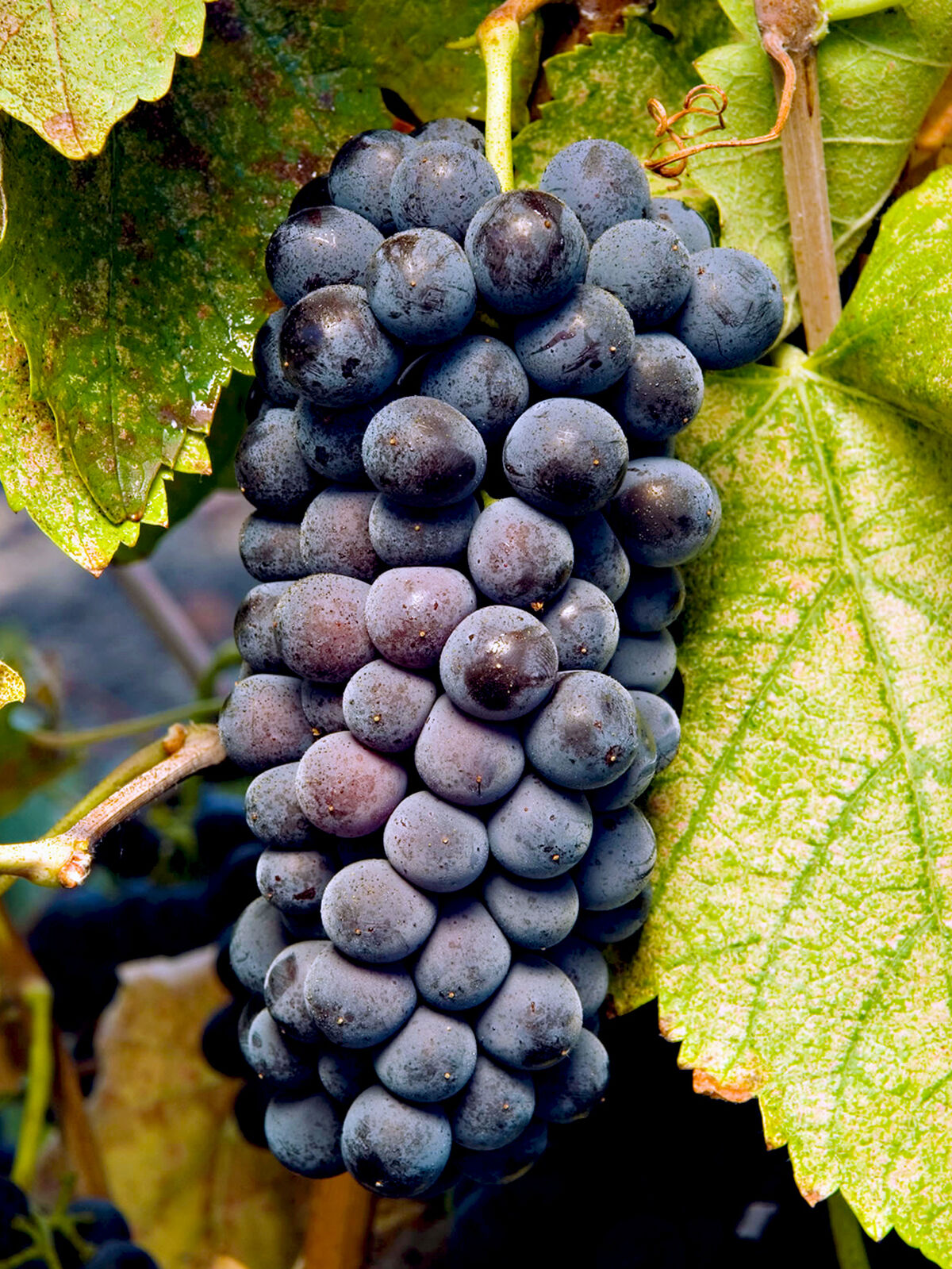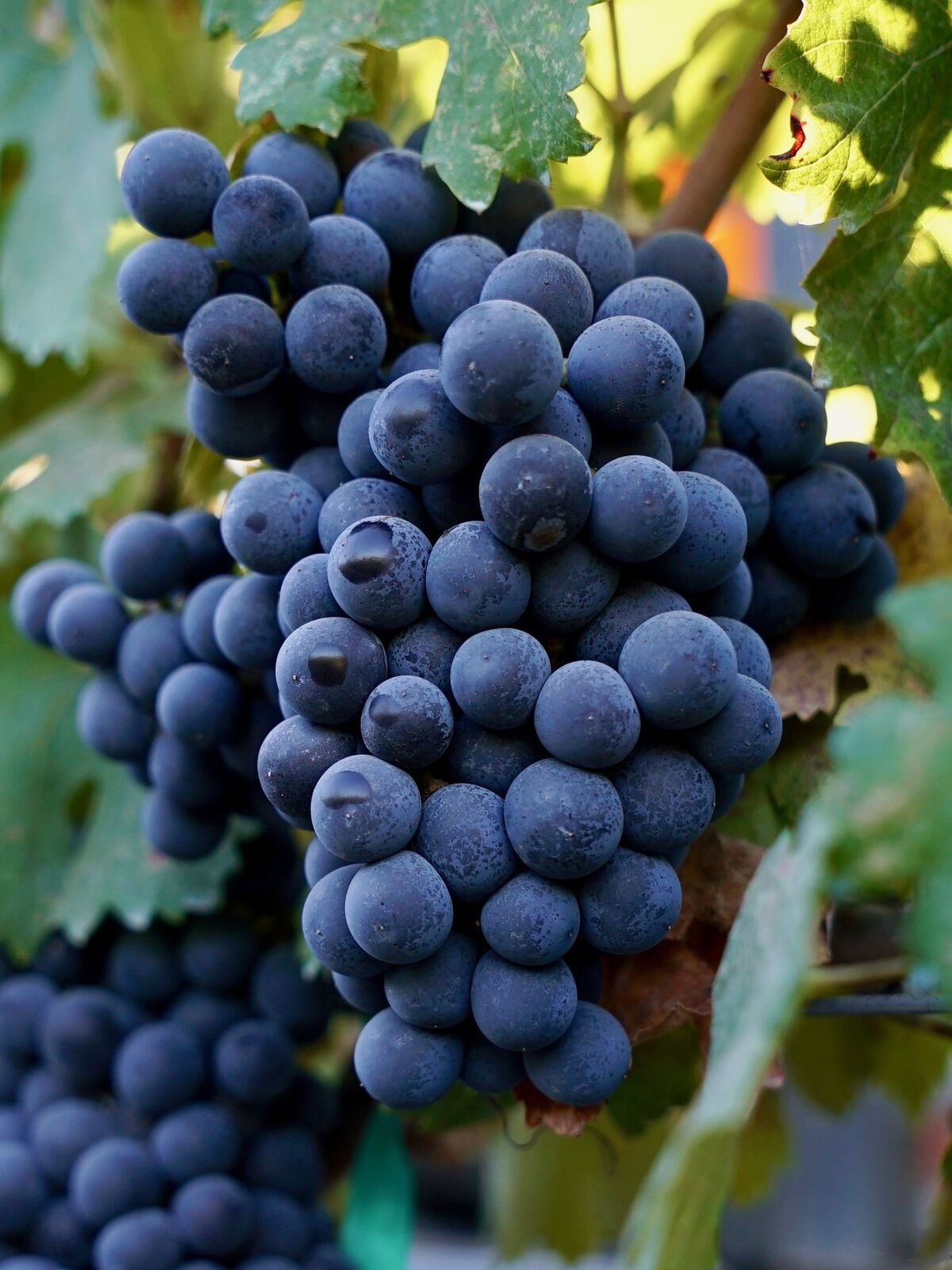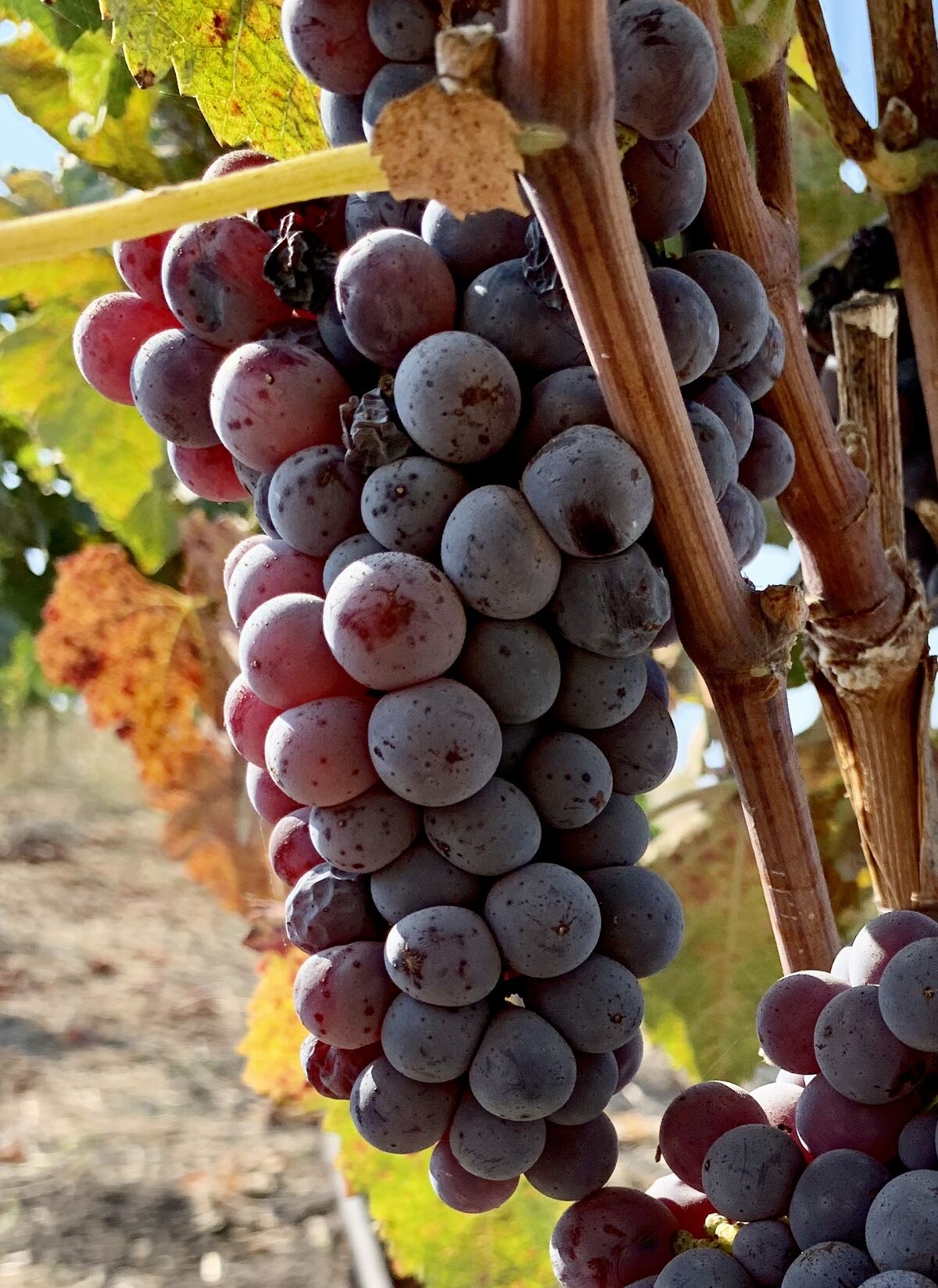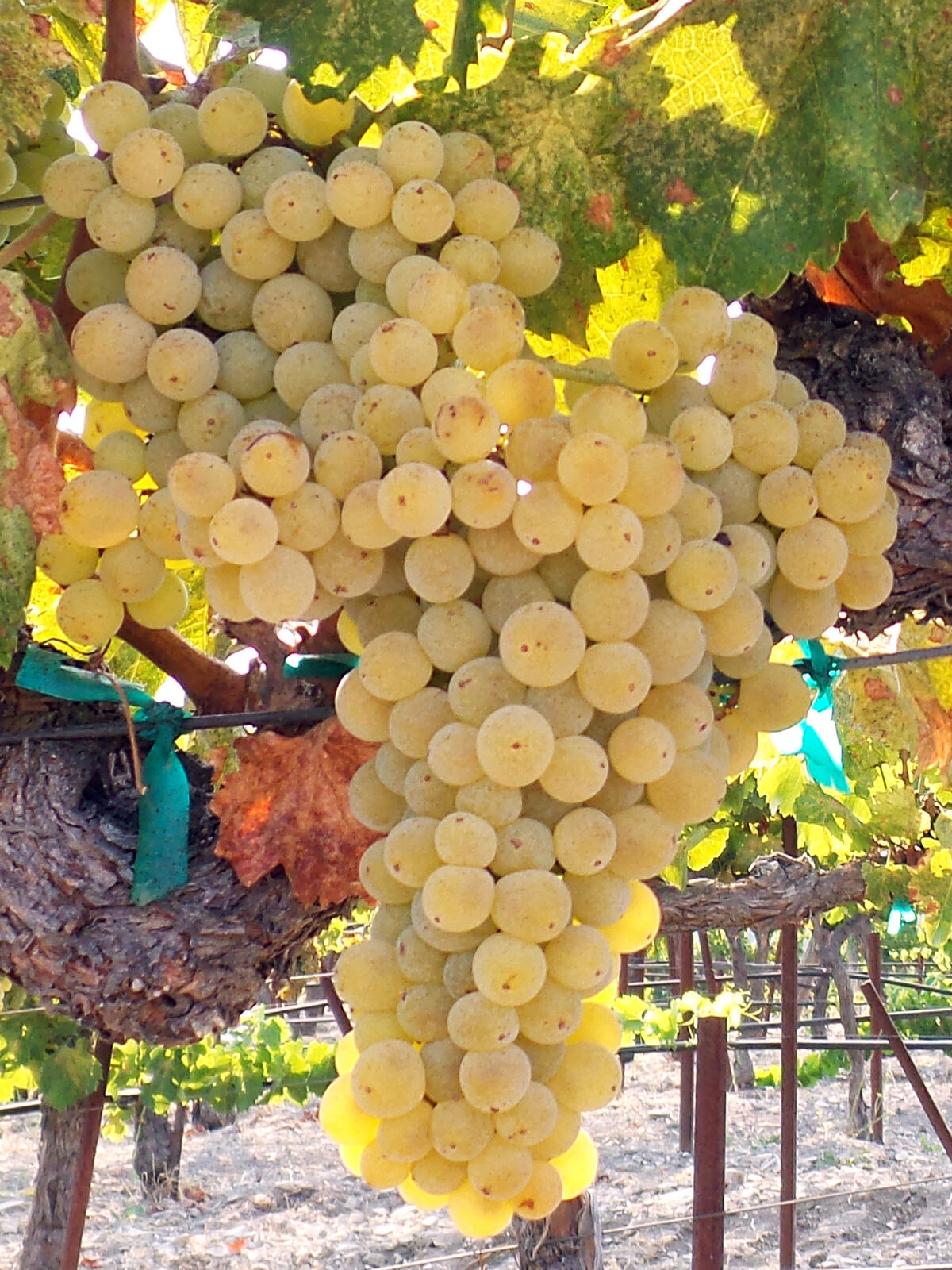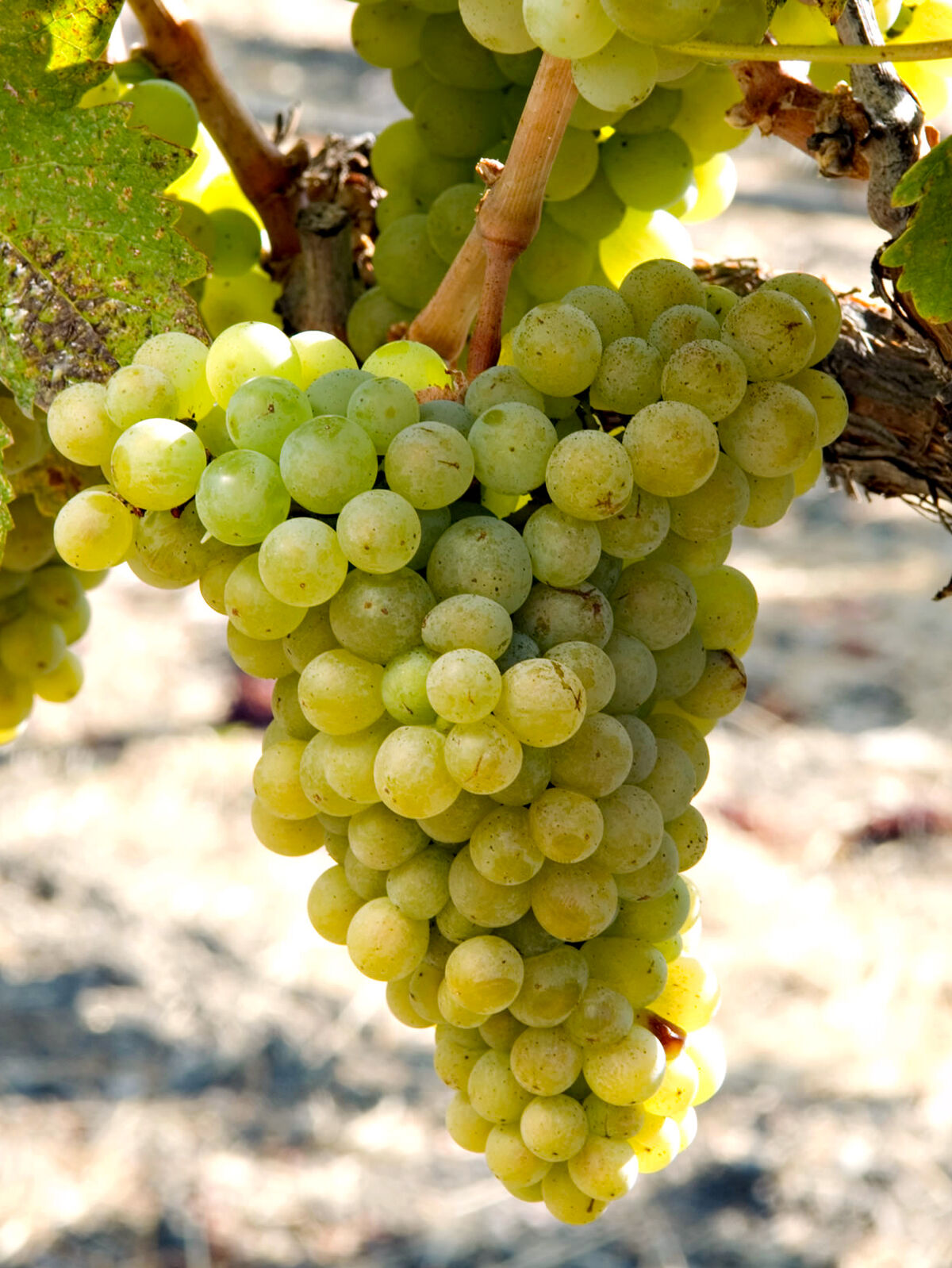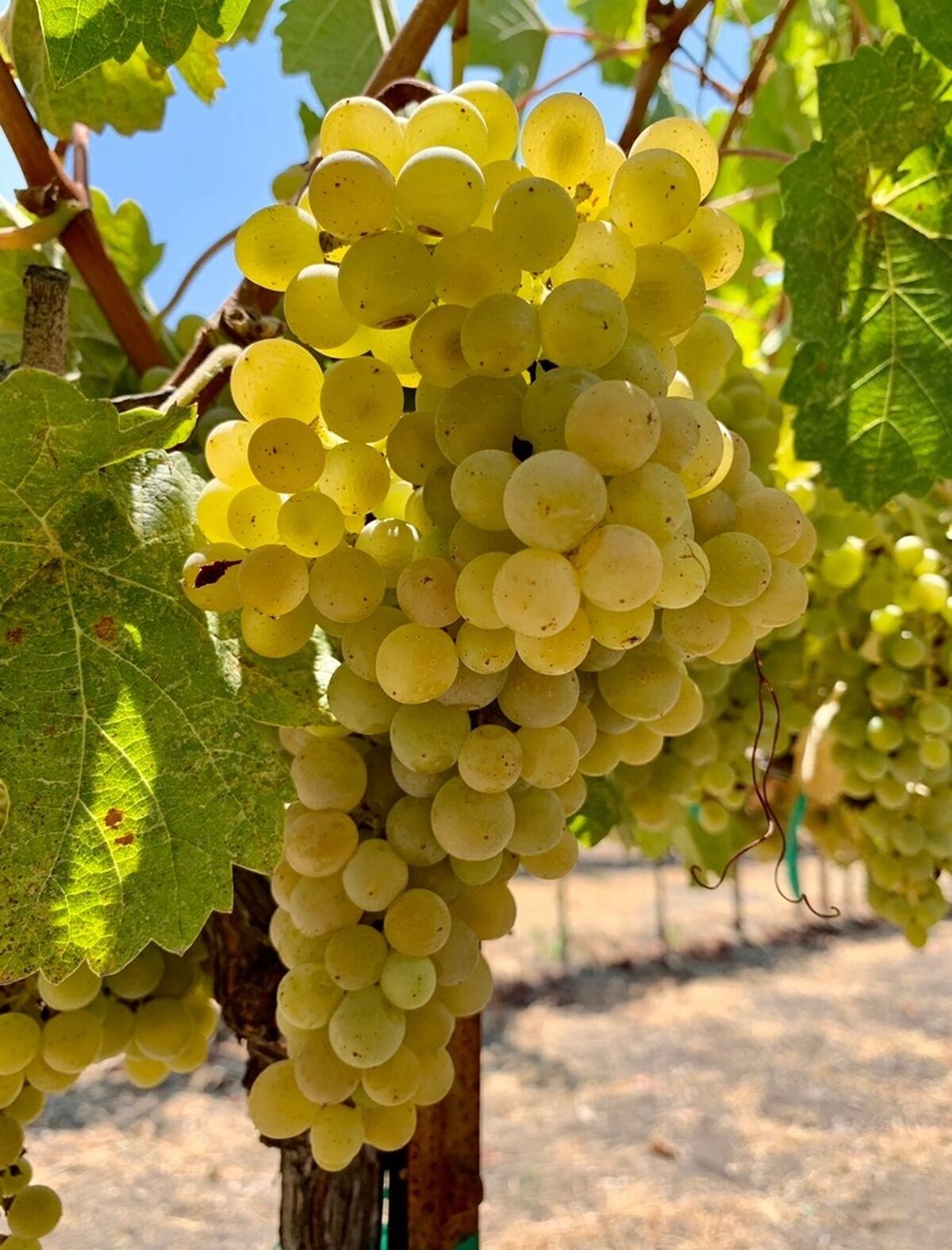Grapes
There are dozens of grapes grown in France's Rhône Valley. 13 of these are approved in Châteauneuf du Pape, with another 8 approved in the Côtes du Rhône appellation. We chose initially to focus on 9 key varietals of the Southern Rhône for our Paso Robles estate vineyard: Mourvèdre, Syrah, Grenache, and Counoise for the reds, and Roussanne, Marsanne, Grenache Blanc, Viognier, and Picpoul for the whites.
More recently, we have imported seven additional grape varieties, with the goal of having the complete Chateauneuf du Pape collection: Clairette, Bourboulenc, Vaccarese, Cinsaut, Picardan, Muscardin, and Terret Noir. You can read about each of these grapes below.
Red Grapes
Mourvèdre
Mourvèdre provides structure, backbone, and aging potential. It tastes of ripe plum and strawberry fruit, with animal flavors of red meat and mushrooms when young, and leather and truffles as it ages. Dark purple-black color.
Historically, Mourvèdre was the most widely planted grape in the Southern Rhône before Phylloxera decimated vineyards in the late 1800s. Replanting was slow, as rootstocks for Mourvèdre were developed only after World War II. Jacques Perrin of Chateau de Beaucastel led regeneration efforts.
Syrah
Syrah provides firm tannin and aromatics, as well as blackberry and currant fruit. It tastes of smoke, tar, and black pepper. Intense dark blue-black color.
Syrah is best known from the the Northern Rhône appellations of Hermitage and Côte-Rotie, where it produces wines of phenomenal elegance and longevity. It is tremendously flexible, and can be made in styles from elegant and restrained through to wines bursting with fruit, in locations as diverse as France, California, South Africa, and Australia (where it is known as Shiraz).
Grenache
Grenache (also known as Grenache Noir) provides fruit, tannin, and acidity. It tastes of currant, cherry, and raisin, with aromatic spice of black pepper, menthol, and licorice. Brilliant ruby red color.
Grenache is the most widely planted grape in the Rhône Valley. It is vigorous, and at high production makes wines that are simple, friendly and approachable. When production is restricted, Grenache can assume tremendous depth and longevity, yet can still open up tighter, more tannic varietals such as Syrah and Mourvèdre.
Counoise
Counoise tastes of blueberry and strawberry fruit with spice notes of cinnamon and nutmeg. It has fresh acidity, soft tannins and is a translucent purple-red color.
One of the lesser-known Châteauneuf du Pape varietals, Counoise's bright acids, brambly spice and soft tannins act as a compliment for the more tannic higher-alcohol grapes such as Syrah. Counoise was first brought into the United States by Tablas Creek, and recognized by the BATF in 2000.
Cinsaut
Cinsaut (often spelled Cinsault, and known by several other names around the Mediterranean) is a relatively new arrival at Tablas Creek, first planted in 2017. Its aromas of spicy raspberry, violet, and black tea, and flavors of tart cherry, redcurrant, and new leather suggest it will be a useful blending partner to higher-alcohol, more tannic red grapes, and it makes a delicious lighter red on its own. We also look forward to exploring its potential as a rosé grape.

Terret Noir
Terret Noir is an ancient grape from the Languedoc, but one whose footprint in Châteauneuf-du-Pape has declined to just 2 acres. We imported it in 2003 as a part of our quest to get all 13 traditional Châteauneuf-du-Pape varieties, and have been pleased to discover its combination of vibrant spiciness, pale color, low alcohol, and grippy structure.
Vaccarèse
Vaccarèse is an ancient grape from the south of France, but rare nowadays, with just 10 acres planted in Châteauneuf-du-Pape and little more than that elsewhere. We imported it in 2003 as a part of our quest to get all 13 traditional Châteauneuf-du-Pape varieties, and have been pleased with its dark color, herbal and floral aromatics, and lively acidity. Our first vintage came in 2019.
Muscardin
Muscardin is a rare grape that appears never to have been very common, or found anywhere outside the Rhone. With only 27 acres planted in the Châteauneuf-du-Pape and even less in the rest of France, it represents one of the more obscure varieties. We imported it in 2003 as a part of our quest to get all 13 traditional Châteauneuf-du-Pape varieties. Muscardin is the 13th and final grape from that quest completed in 2019. We look forward to seeing what it produces in our cellar as early as the 2020 harvest.
White Grapes
Roussanne
Roussanne provides golden color, rich texture, floral aromatics, flavors of honey and pear fruit, and excellent aging potential. With time, Roussannes gain caramel and hazelnut aromatics, making it one of the world's most ageworthy whites.
Roussanne is notoriously difficult to grow, and has in much of the world been replaced with the more amenable Marsanne. But at Beaucastel, it makes one of the world's greatest whites, and its structure and texture makes it a terrific blending partner.
Viognier
Viognier is highly aromatic, with a nose of peach, apricot, and citrus blossom. It has a rich mouthfeel with more stone fruit. Pale pink-gold color.
Viognier is grown in the Northern Rhône valley, and reaches its peak in the appellations of Condrieu and Château Grillet. In California, it is by far the most-planted white Rhone grape, producing rich, tropical wines bottled varietally or in blends.
Grenache Blanc
Grenache Blanc has firm acidity, green apple and citrus flavors, and white flower aromatics.
Grenache Blanc is the tenth most widely planted white grape in France, and the fastest-growing white Rhone in acreage in California. Its combination of good richness and crisp acids makes it a great blending component, brightening many of the lower-acid white Rhône grapes without thinning the mouthfeel. Tablas Creek was the first winery to import Grenache Blanc into the United States, and it was recognized by the BATF in 2003.
Marsanne
Marsanne tastes of melon and minerals, and has a golden straw color.
Marsanne is a flexible and adaptible grape found throughout the Rhône valley. It reaches its peak in the appellation of Hermitage in the Northern Rhône, where it is often blended with Roussanne. Its tendency to pick up mineral character from the soils makes it an important piece of many wines which wish to express the terroir of their site.
Picpoul
Picpoul (often known as Picpoul Blanc) gets its root from the french word piquer, “to sting”, a reference to its high acidity. In France, wines from Picpoul are celebrated for their bright acidity, minerality, and clean lemony flavor.
Picpoul has thrived in California since we brought it in. California's climate adds a tropical lushness to Picpoul's brightness -- reminiscent of Piña Colada -- that makes it both delicious on its own and an excellent blending component.
Clairette Blanche
Clairette Blanche (pronounced Kleh-RHEHT BLAHNSH) is a grape that was once one of the most widely planted white grapes in the south of France, and while acreage has declined, is still used in a variety of ways, including as a component of the Rhone's best-known sparkling wine. It's still relatively new to us at Tablas Creek, in production just since 2014, but like its potential for fresh wines with nutty richness.
Picardan
Picardan is a grape whose first mention talks about it being "very common", but has significantly decreased in plantings since then, with just over an acre reported to be planted in France. It's still relatively new to us at Tablas Creek, in production just since 2016, but we are excited by its bright finish and rich flavors that, since 2017, have been blended into our flagship white wine, Esprit de Tablas Blanc.
Bourboulenc
Bourboulenc is an ancient white grape from the region surrounding Avignon, valued in France for its vigor, floral character and ability to maintain acids in warm climate. Our two-thirds of an acre, planted in 2016, was the first acreage outside its French homeland. We harvested our first Bourboulenc crop in 2019, and feel it has potential both as a varietal wine and in our blends.
Non-Rhône Varietals
In addition to our Rhône varietals, we are one of the only California wineries to grow Tannat and Vermentino.
More information about these and other Rhône varietals can be found online. Two particularly good resources are the Rhône Rangers and the Hospice du Rhône.


